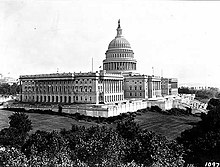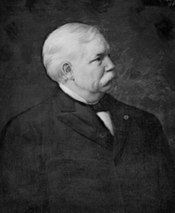57th United States Congress
| 57th United States Congress | |
|---|---|
56th ← → 58th | |
 United States Capitol (1906) | |
March 4, 1901 – March 4, 1903 | |
| Members | 90 senators 357 representatives 5 non-voting delegates |
| Senate majority | Republican |
| Senate President | Theodore Roosevelt (until September 14, 1901) Vacant (from September 14, 1901) |
| House majority | Republican |
| House Speaker | David B. Henderson |
| Sessions | |
| Special: March 4, 1901 – March 9, 1901 1st: December 2, 1901 – July 1, 1902 2nd: December 1, 1902 – March 3, 1903 | |
The Fifty-seventh United States Congress was a meeting of the legislative branch of the United States federal government, composed of the United States Senate and the United States House of Representatives. It met in Washington, DC from March 4, 1901 to March 4, 1903, during the final six months of William McKinley's presidency, and the first year and a half of the first administration of his successor, U.S. President Theodore Roosevelt. The apportionment of seats in the House of Representatives was based on the Eleventh Census of the United States in 1890. Both chambers had a Republican majority.
Major events
- September 6, 1901: Leon Czolgosz shot President William McKinley at the Pan-American Exposition in Buffalo, New York
- September 14, 1901: President William McKinley died. Theodore Roosevelt became President of the United States
- October 16, 1901: President Roosevelt invited African American leader Booker T. Washington to the White House. The American South reacted angrily to the visit, and racial violence increased in the region.
- December 3, 1901: President Roosevelt delivered a 20,000-word speech to the House of Representatives, asking Congress to curb the power of trusts "within reasonable limits."
- February 22, 1902: Senators Benjamin Tillman and John L. McLaurin, both of South Carolina, have a fist fight while Congress is in session.[1] Both Tillman and McLaurin were later censured by the Senate on February 28.
- June 2, 1902: The Anthracite Coal Strike by the United Mine Workers began, continuing until October 21, 1902.
- July 4, 1902: The Philippine–American War ended
Major legislation
- June 17, 1902: Newlands Reclamation Act
- June 28, 1902: Isthmian Canal Act (Panama Canal), Sess. 1, ch. 1302, 32 Stat. 481
- January 21, 1903: Militia Act of 1903 (Dick Act), 32 Stat. 775
- February 11, 1903: Expediting Act, Sess. 2, ch. 544, 32 Stat. 823
- February 19, 1903: Elkins Act
- March 3, 1903: Immigration Act of 1903, including §39, the Anarchist Exclusion Act
Party summary
Senate
| Party (shading shows control) |
Total | Vacant | |||||
|---|---|---|---|---|---|---|---|
| Democratic (D) |
Populist (P) | Republican (R) | Silver (S) | Silver Republican (SR) |
|||
| End of previous congress | 23 | 7 | 54 | 2 | 2 | 88 | 2 |
| Begin | 28 | 2 | 53 | 0 | 3 | 86 | 4 |
| End | 56 | 89 | 1 | ||||
| Final voting share | 31.5% | 2.2% | 62.9% | 0.0% | 3.4% | ||
| Beginning of next congress | 33 | 0 | 55 | 0 | 2 | 90 | 0 |
- Note: Fred T. Dubois (Idaho) was elected as a Silver Republican, but changed parties to Democratic after this Congress began.
House of Representatives
- Democratic: 151
- Republican: 200 (majority)
- Populist: 5
- Silver (Silver Republican): 1
TOTAL members: 357
Leadership

Theodore Roosevelt
Senate
- President: Theodore Roosevelt (R), until September 14, 1901, vacant thereafter.
- President pro tempore: William P. Frye (R)
- Democratic Caucus Chairman: James K. Jones (D)
- Republican Conference Chairman: William B. Allison (R)
House of Representatives
- Speaker: David B. Henderson (R)
- Democratic Caucus Chairman: James Hay (D)
- Republican Conference Chairman: Joseph G. Cannon (R)
Majority (Republican) leadership
Minority (Democratic) leadership
Members
This list is arranged by chamber, then by state. Senators are listed in order of seniority, and Representatives are listed by district.
Senate
At this time, Senators were elected by the state legislatures every two years, with one-third beginning new six-year terms with each Congress. The Senate class numbers, which indicate the cycle of their election, precede the names in the list below. In this Congress, Class 1 meant their term began in the last Congress, requiring reelection in 1904; Class 2 meant their term began with this Congress, requiring reelection in 1906; and Class 3 meant their term ended with this Congress, requiring reelection in 1902.
House of Representatives
Changes in Membership
This section is empty. You can help by adding to it. (December 2009) |
Employees
- Architect of the Capitol: Edward Clark, died January 6, 1902.
- Elliott Woods, appointed February 19, 1902.
Senate
- Secretary: Charles G. Bennett
- Sergeant at Arms: Daniel M. Ransdell
- Chaplain: William H. Millburn, Methodist
- F.J. Prettyman, Methodist, elected December 2, 1902.
House of Representatives
- Clerk: Alexander McDowell
- Sergeant at Arms: Henry Casson
- Doorkeeper: William J. Glenn
- Postmaster: Joseph C. McElroy
- Clerk: Asher C. Hinds
- Chaplain: Henry N. Couden, Universalist
References
- ^ "SENATORS FIGHT ON SENATE FLOOR; McLaurin and Tillman of South Carolina Come to Blows. BOTH ADJUDGED IN CONTEMPT They Apologize, but Committee Will Pass on the Affair. Fisticuffs Followed McLaurin's Assertion That Tillman Had Lied About Him in the Course of Philippine Debate". The New York Times. February 23, 1902.
- Gould, Lewis L. (2005). The Most Exclusive Club. Cambridge, MA: Perseus Books Group. ISBN 0-465-02778-4.
{{cite book}}: Cite has empty unknown parameter:|coauthors=(help) - Remini, Robert V. (2006). The House. New York: HarperCollins Publishers, Inc. ISBN 0-06-088434-7.
{{cite book}}: Cite has empty unknown parameter:|coauthors=(help) - U.S. Congress (2005). "Biographical Directory of the U.S. Congress". Archived from the original on June 1, 2006. Retrieved June 1, 2006.
{{cite web}}: Cite has empty unknown parameter:|coauthors=(help); Unknown parameter|deadurl=ignored (|url-status=suggested) (help) - U.S. House of Representatives (2006). "Congressional History". Archived from the original on June 1, 2006. Retrieved June 1, 2006.
{{cite web}}: Cite has empty unknown parameter:|coauthors=(help); Unknown parameter|deadurl=ignored (|url-status=suggested) (help) [dead link] - U.S. Senate (2006). "Statistics and Lists". Archived from the original on June 1, 2006. Retrieved June 1, 2006.
{{cite web}}: Cite has empty unknown parameter:|coauthors=(help); Unknown parameter|deadurl=ignored (|url-status=suggested) (help)

